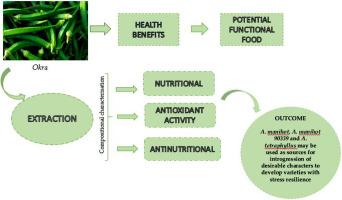Nutritional, antinutritional and antioxidant assessment of immature Abelmoschus pods: Implications for crop improvement from cultivated and wild varieties
IF 4.6
Q2 MATERIALS SCIENCE, BIOMATERIALS
引用次数: 0
Abstract
Crop wild relatives hold significant potential for enhancing diversity, nutrition, and stress resilience in improvement programs. As such thorough, the biochemical assessment of these wild counterparts becomes indispensable. Okra, a vital vegetable crop renowned for its vibrant green pods, faces various productivity challenges due to diverse stresses, and its nutritional and stress tolerance aspects have been somewhat overlooked. In this current research, an extensive evaluation was conducted on both wild and cultivated okra species to decipher their nutritional, anti-nutritional, and antioxidant profiles. The results of the proximate analysis showed that wild okra exhibited higher nutritional value and antioxidant potential compared to cultivated species. Remarkably among the wild species A. moschatus accessions IC 470737 and IC 140986 stood out for their elevated content of carbohydrates (93.10 % and 69.38 %), soluble sugars (84.36 % and 41.83 %), reducing sugars (19.41 % and 38.11 %), and vitamin E (37.23 % and 51.24 %); whereas A. Manihot and A. tetraphyllus had higher antioxidant potential. Significantly, these wild entries also showcased the reduced anti-nutrient content suggesting high mineral bioavailability compared to cultivated ones. So, these wild genotypes having a good combination of many biochemical characteristics can be used for the introgression of traits in cultivated okra for further end product diversification.

未成熟阿贝尔莫斯卡豆荚的营养、抗营养和抗氧化评估:利用栽培品种和野生品种改良作物的意义
作物野生近缘种在改良计划中具有提高多样性、营养和抗逆性的巨大潜力。因此,对这些野生近缘植物进行生化评估是必不可少的。秋葵是一种重要的蔬菜作物,以其充满活力的绿色豆荚而闻名,但由于受到各种压力的影响,它的产量面临着各种挑战,其营养和抗逆性方面的问题在某种程度上被忽视了。本次研究对野生和栽培秋葵品种进行了广泛评估,以解读它们的营养、抗营养和抗氧化特性。近似分析结果表明,野生秋葵的营养价值和抗氧化潜力均高于栽培品种。值得注意的是,野生秋葵品种IC 470737和IC 140986的碳水化合物(93.10%和69.38%)、可溶性糖(84.36%和41.83%)、还原糖(19.41%和38.11%)和维生素E(37.23%和51.24%)含量较高;而A. Manihot和A. tetraphyllus的抗氧化潜力较高。值得注意的是,与栽培品种相比,这些野生品种的抗营养素含量也有所降低,表明矿物质的生物利用率较高。因此,这些野生基因型具有多种生化特性的良好组合,可用于栽培秋葵的性状导入,以进一步实现最终产品的多样化。
本文章由计算机程序翻译,如有差异,请以英文原文为准。
求助全文
约1分钟内获得全文
求助全文

 求助内容:
求助内容: 应助结果提醒方式:
应助结果提醒方式:


